Scotch Eggs: Important Temperatures
People love eating breakfast for dinner. Don’t deny it, you do, too! There’s something that is at once comforting and somehow wicked about eating waffles or pancakes with hash browns and bacon after work. It’s everything American food culture loves. Except that it isn’t deep-fried. But what if it were?
Enter the scotch egg. This pub food from Britain is a boiled egg that is wrapped in sausage, breaded, and then deep fried. (Sorry, there’s no actual Scotch involved.) Scotch eggs are popular fare in English pubs and at picnics, often dipped or slathered in tangy mustard. Recipes and variations abound, but the one we’ll present today uses breakfast sausage for the meat and cornflakes for the breading. And there you have it, a whole deep-fried breakfast—eggs, sausage, and corn flakes. Read on and learn how to master these beautiful treats, and surprise your friends with something new at your next college basketball tournament party.
Qualities of a good scotch egg
A good scotch egg has many qualities, some of which are opinion, others are pretty hard-drawn rules. First, the egg. I prefer my yolk to be either still slightly runny or barely set and still dark orange in color. The textural appeal of this doneness is second to none, and to me, it beats a dry, chalky yolk any day of the week. However, that is subjective. If you love hard boiled eggs, by all means, use them.
The next check for quality is the sausage coating. Obviously, you should use the best tasting sausage you can, as it will be the predominant flavor in the dish. However, the application of the sausage is equally important. We want an egg wrapped in sausage, not a sausage ball stuffed with egg—the thickness of the sausage coating is important. Something just thicker than an eighth of an inch is about right—a quarter of an inch is too thick. Patty the sausage out as thin as you can before wrapping it around the egg, then remove any extra-thick bits that may have accumulated in the wrapping process.
Finally, we come to the breading. The fried breading must be deep golden brown and crunchy without being overdone. Some people bake their scotch eggs to avoid the fat from the fryer. Good for them, I guess, but they’re missing half the point. In this recipe, as noted above, we use well-crushed corn flakes for the breading. Because they start out crunchy, they are great for bringing the crunch quotient up to an appropriate level. Also, the breading needs to be fried crisp but not soggy with oil. As with any fried food, that means cooking it hot enough to sizzle wildly but not so hot that everything burns before it can cook through. We’ll use our ChefAlarm® to help keep our oil temperature in the right range to get perfectly browned spheroids and our Thermapen®® Mk4 to make sure we’re not eating undercooked sausage.
Scotch Eggs Recipe
Based on a recipe from Bon Appetit
Scotch Egg Ingredients
- 6 large eggs (though using 8 is a good idea)
- 1 cup all-purpose flour
- 1 cup finely crushed corn flakes
- 7 ounces (¾ cup) fresh breakfast (or other!) sausage, casings removed if necessary
- Kosher salt, freshly ground pepper
- Vegetable oil (for frying)
- Mustard
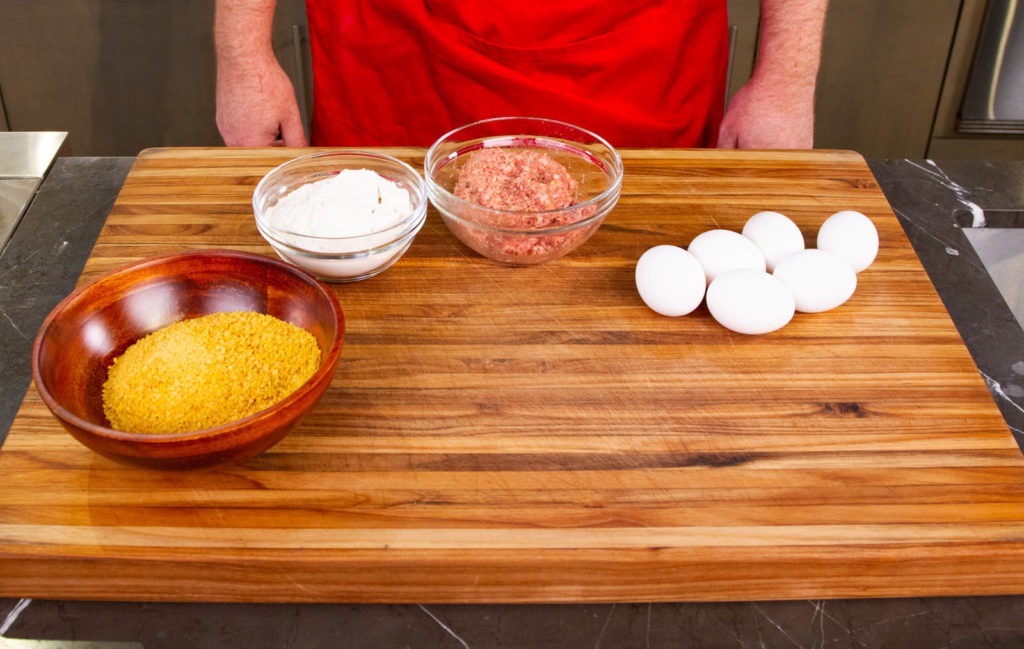
Instructions
- Put four of the eggs in a saucepan and cover with cold water. Bring to a boil; remove from heat and cover, allowing to stand for 3 minutes. Note: this will result in a set, but very soft, yolk. If you want a hard boiled egg, follow our instructions for perfect hard-boiled eggs. If you want something runnier, shorten the time.
- If you have 8 eggs, boil six. One or two eggs will inevitably crack or get ruined in peeling. Having a backup egg or two is smart.

- Drain the eggs and refill the pan with ice water. Allow the eggs to cool.
- Carefully peel the eggs under cold running water.

- Begin preheating 3 inches of high-smoke point, neutral-flavored oil, like corn or peanut oil.
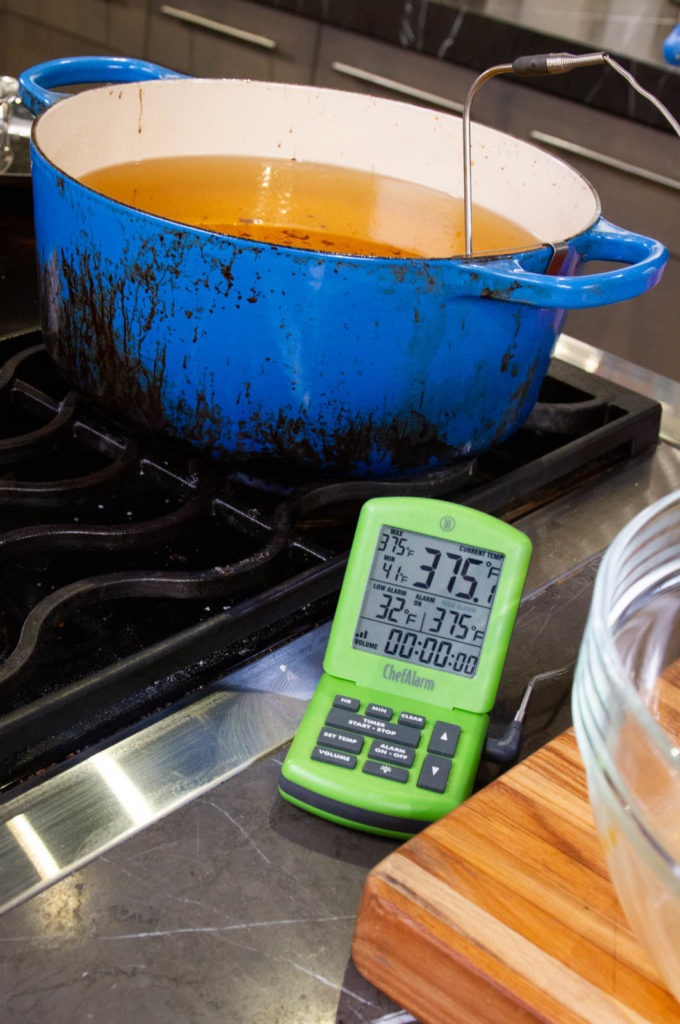
- Clip a probe to the edge of the pan and set your ChefAlarm’s high alarm to 375°F (191°C).
- Beat the remaining two eggs in a small bowl. Pour the flour into a bowl and the crushed cornflakes into another bowl.
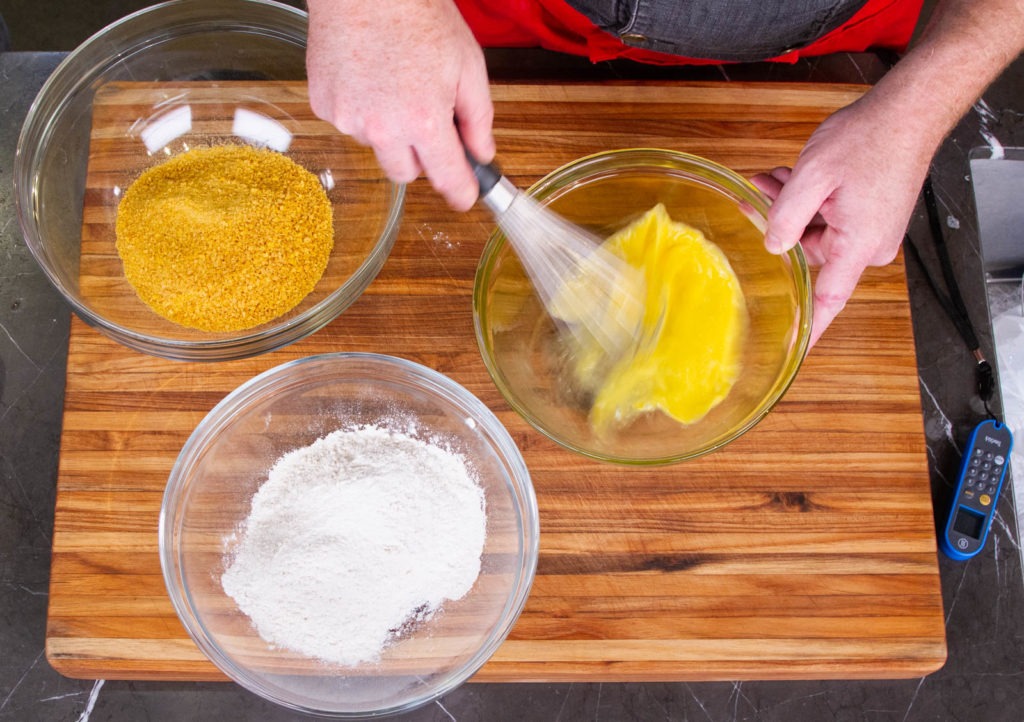
- Use ¼ of the sausage to make a very thin, flat patty by smashing the sausage between your hands and kind of flopping the patty back and forth between your hands. Aim for a patty just about 1/8–3/16 of an inch thick.
- Wrap an egg in the sausage by holding the sausage in the cupped palm of one hand and nesting an egg in the divot. Fold the edges up around the egg and pinch the sausage together. Make sure there are no bare spots of egg showing and if there are any extra thick bits of sausage, pinch the excess off.

- Roll the sausage-covered egg in the flour.
- Roll the floured egg in the beaten egg wash.
- Roll the eggy ball in the cornflakes. Set it on a plate to await frying.
- Repeat with three more boiled eggs.

- Once the oil has come to temperature, carefully lower 2-4 breaded eggs into the hot oil. Turn the heat up, as the frying eggs will release steam and drive the oil temperature down, slowing the cooking process and creating oil-soaked breading.
- Monitor the heat by watching the ChefAlarm. Adjust as necessary.
- Once the eggs have fried for about 4-5 minutes and are golden brown, remove one and check the temperature of the sausage with a Thermapen®. It should be 150°F (66°C).
- Remove the eggs to a cooling rack or a plate lined with paper towels to absorb excess oil.

- If you didn’t fry them all yet, fry the next batch, allowing the oil to first reheat to 375°F (191°C).
- Allow to cool slightly, and serve with good mustard and maybe some pickles to cut the heaviness of the dish.
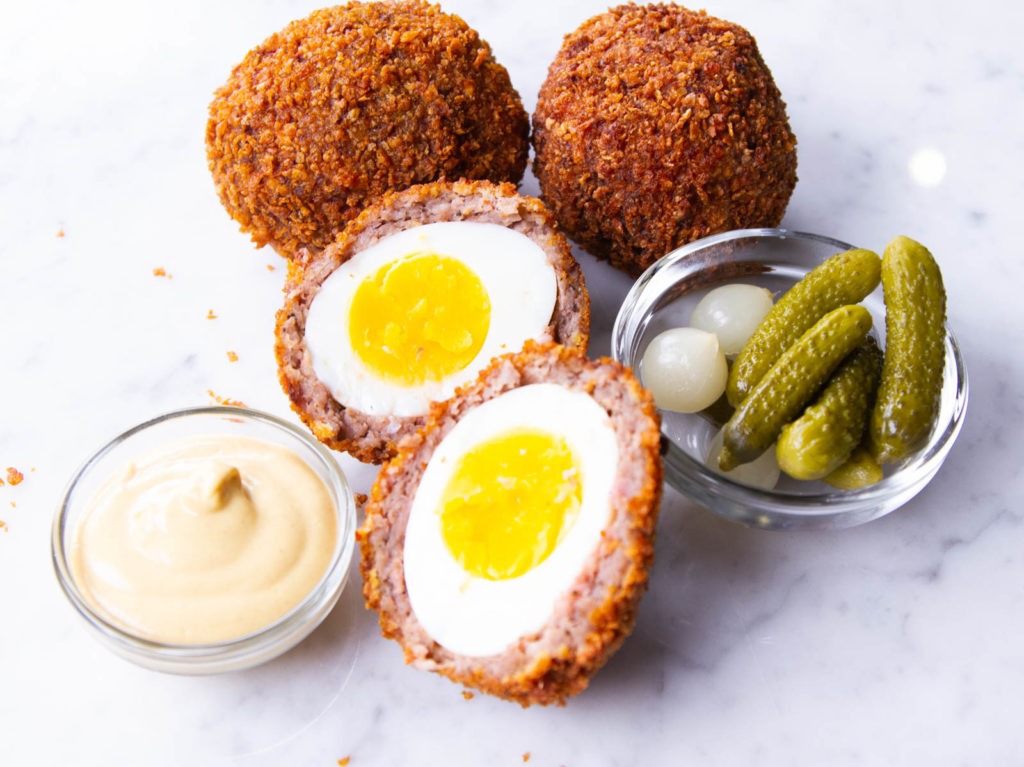
Scotch eggs are a sinful delight. A whole breakfast, deep fried and eaten for a bar snack…what more could you want! And they are beautifully customizable. Try them with chorizo, or use some beer brat meat that has been freed from its casings to wrap the eggs. Try other
Shop now for products used in this post:


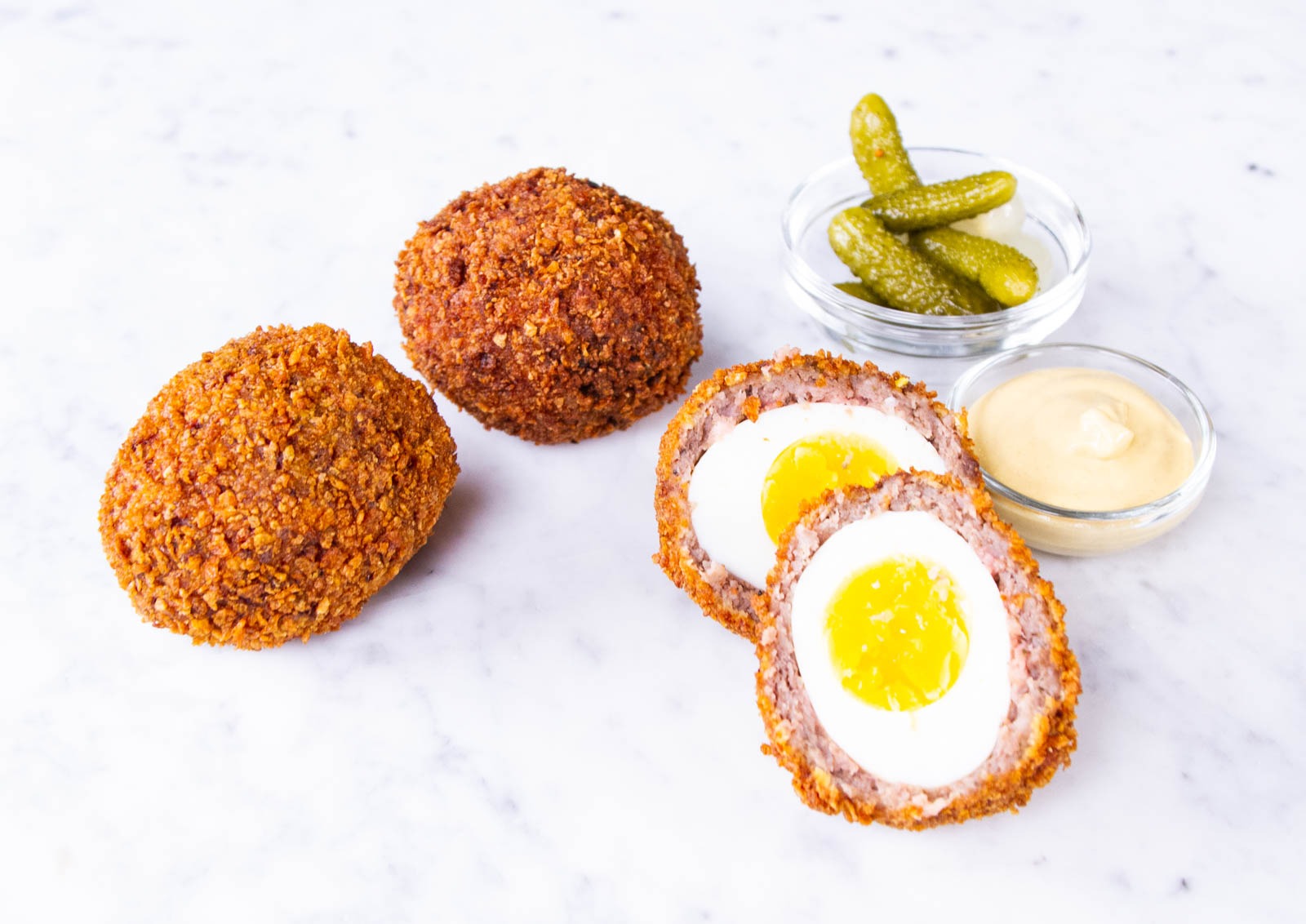
If you do choose to bake the eggg, what temperature should you use, and how long to cook them?
Barbara,
You’ll want to cook them in a relatively hot oven, say 375°F. The time it will take to cook will depend on the sausage thickness. I’d plan on 15-20 minutes. Obviously, cooking to temperature is best, so if you have a very thin probe, like our needle probe, you could slide it into the layer so that it’s reading the temperature right next to the egg. Cook it until it reached 150°F.
If you try it, let us know how it goes!
you can use 2 squares of parchment paper to roll out the sausage to desired thickness, making it easily even. remove one layer of parchment, place egg on sausage and use the bottom piece of parchment, still in place, to help lift and position the sausage around the egg without tearing. then repeat, using same parchment pieces for remaining sausage. also, if you have rolling rings, use the 1/8″ to insure that’s the thickness you get. also, these can be cooked on a smoker – think Traeger – and they’re delicious that way, too.
Linn,
Fantastic advice! Thanks for commenting!
You did not specify a type of sausage, but for food safety it is usually recommended to be in the 160°F to 165°F temp range, for ground meats (based on the type), unless I missed something.
Michael,
Yes, 160°F is usually correct for sausage, etc. Here where we had such a thin coating and the temps were so high, we hazarded 150°F because we didn’t want our eggs getting too rubbery. By all means, cook to 160°F, especially if you are in a high-risk category!
What about an air fryer??
Paul,
It ought to work…
This might be the most useful product-related email I’ve received this year. I can’t wait to try this with my ChefAlarm.
SG,
Thank you! Happy cooking!
I like to serve these in a nest of hash brown potatoes. We call them “Dragon Eggs”.
Fantastic!